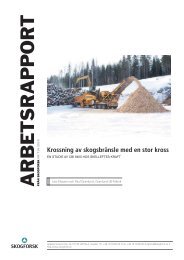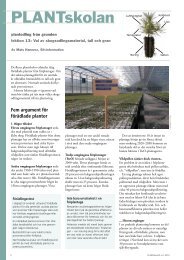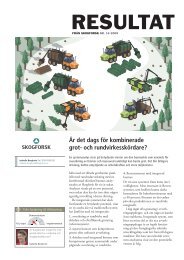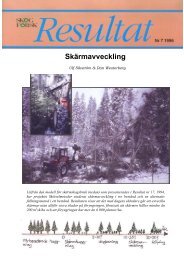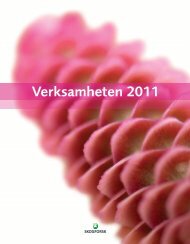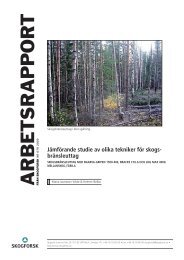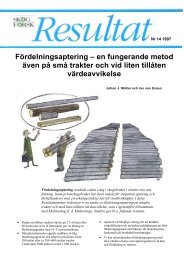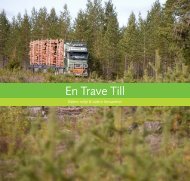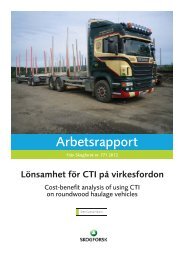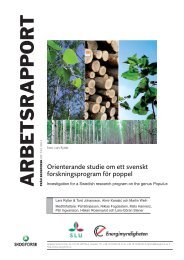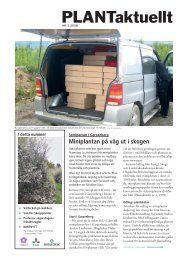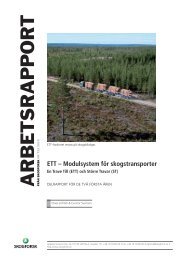Skogforsk News No.1, 2008
Skogforsk News No.1, 2008
Skogforsk News No.1, 2008
You also want an ePaper? Increase the reach of your titles
YUMPU automatically turns print PDFs into web optimized ePapers that Google loves.
No. 1 <strong>2008</strong><br />
ARTICLES<br />
NEWS ITEMS<br />
NEW PUBLICATIONS<br />
FROM SKOGFORSK<br />
NEWS<br />
Productivity in forestry<br />
just keeps rising (p.4)<br />
Award for logistics<br />
experts<br />
Mikael Rönnqvist,<br />
one of the winners of<br />
the prestigious award<br />
Multitree-handling<br />
taking off<br />
<strong>Skogforsk</strong>’s project<br />
was a kick-start,<br />
says Jan Åhlund<br />
Stumpwood can<br />
give 5–10 TWh<br />
Latest news on<br />
stumpwood from<br />
Henrik von Hofsten
Logistics prize<br />
Mikael Rönnqvist and Mikael Frisk,<br />
both at <strong>Skogforsk</strong>, are two of the<br />
authors of a paper that won the<br />
Management Science Strategic<br />
Innovation Prize 2007 (MSSIP) in the<br />
face of stiff competition.<br />
The prize was awarded by the<br />
Association of European Operational<br />
Research Societies, at a large<br />
conference in Prague. The two<br />
other authors of the prestigious<br />
paper were Kurt Jörnsten, of the<br />
Norwegian School of Economics<br />
and Business Administration (NHH),<br />
and Maud Göthe-Lundgren, of the<br />
Swedish National Road and Transport<br />
Research Institute (VTI).<br />
The research is part of a three-year<br />
project, which is looking into the<br />
distribution of costs in the transport<br />
sector, and is using the forestry sector<br />
as an example.<br />
The four researchers have investigated<br />
how eight forest enterprises<br />
in southern Sweden can reduce<br />
haulage costs in a collaboration to<br />
optimize route planning.<br />
“Our studies have shown that when<br />
the enterprises optimize the routes<br />
individually, they can achieve a 5%<br />
reduction in haulage costs if they can<br />
secure a return load,” says Mikael<br />
Rönnqvist. “However, if instead the<br />
enterprises work together, haulage<br />
costs can be reduced by at least<br />
14%”.<br />
“The benefits should be shared<br />
as fairly as possible among the<br />
collaborating companies,” says<br />
Rönnqvist. “To do this, we have<br />
developed a new method that is able<br />
to take into account the total volume<br />
that each company has contributed<br />
to the scheme. We call this the<br />
equal-gain method..<br />
“This prize underlines the advanced<br />
position that <strong>Skogforsk</strong> occupies in<br />
the field of scientific research both<br />
in Scandinavia and internationally,”<br />
concludes Rönnqvist.<br />
Tough target: 50% rise in<br />
productivity by 2020<br />
<strong>Skogforsk</strong> has launched a large, offensive,<br />
development programme in forest<br />
technology: “Environmental and efficient<br />
forest technology 2020”.<br />
The goals are challenging — by 2020,<br />
the forestry sector shall achieve:<br />
• 50% rise in productivity<br />
• 50% shorter lead times<br />
• Reduced fuel consumption and<br />
emissions<br />
• Better operator ergonomics<br />
• Reduced environmental impact<br />
• Increased wood value<br />
• A more attractive workplace.<br />
To achieve these goals, intensified<br />
research is to take place in four main<br />
areas, as shown below.<br />
“We want to establish a wide international<br />
collaboration in the programme,”<br />
says Lennart Rådström, who<br />
is coordinating the work at <strong>Skogforsk</strong>.<br />
The four main programme fields<br />
“Discussions are now taking place<br />
with Finnish and Canadian research<br />
institutes, and others. We have also<br />
invited machine manufacturers and<br />
users to participate in the work”, he<br />
says.<br />
A number of projects are already<br />
under way; these include work on<br />
the automation of knuckleboom<br />
manipulation, and systems analysis of<br />
machine concepts.<br />
“We are now working hard to get<br />
financial support from the EU, and<br />
other national and international<br />
research financiers,” says Rådström.<br />
Interested in more information<br />
about the the programme and how to<br />
be a partner Please contact Lennart<br />
Rådström.<br />
The digital chain in forest operations<br />
• Market and customer needs<br />
• Logistics<br />
• Forest inventories<br />
New machine<br />
concepts<br />
• Systems analyses<br />
• Off-road-vehicle dynamics<br />
• Power sources<br />
• Ground–vehicle interaction<br />
Contact: Lennart Rådström<br />
Phone: +46 18 188550<br />
lennart.radstrom@skogforsk.se<br />
• Information and decisionsupport<br />
systems<br />
• Tracing and monitoring systems<br />
New machine control<br />
concepts<br />
• Human-Machine Interaction (HMI)<br />
• Automation<br />
Mikael Rönnqvist<br />
Productivity research<br />
• Research concerning the factors and<br />
relationships behind productivity in<br />
forestry operations:<br />
• Approaches in other business sectors<br />
• Terminology and productivity<br />
relationships<br />
Cover photo: Staffan Claesson.<br />
2 NEWS No. 1 <strong>2008</strong>
Productivity just continues to rise<br />
The volume of timber harvested per manday<br />
grows relentlessly, and will soon pass<br />
the 30-cubic-metre threshold. Over the past<br />
50 years in Sweden, productivity levels have<br />
risen by an average of 5% a year!<br />
The graph shown here is a familiar<br />
one to forestry folk in Sweden. The<br />
initial one was drawn up in the days of<br />
Skogsarbeten — the Logging Research<br />
Foundation. The graph has now been<br />
updated, with the new data having<br />
been produced to the end of 2005.<br />
The graph is often used to show other<br />
sectors that forestry is neither stuck<br />
in the past nor in the mud — we are<br />
talking of a high-tech sector here!<br />
m 3 per man-day<br />
Copies of the chart are available free of<br />
charge from the <strong>Skogforsk</strong> website:<br />
www.skogforsk.se/forskning<br />
How long can the trend continue<br />
“I am convinced that the sharp upward<br />
trend will continue,” says Magnus<br />
Thor, who is head of the technology<br />
programme at <strong>Skogforsk</strong>. “With<br />
continued rationalization, further<br />
research, and new technology, we<br />
should be able to push the curve even<br />
higher”.<br />
In the near future, thanks to<br />
multitree-handling and unmanned<br />
harvester systems like the Besten,<br />
productivity will increase substantially.<br />
Important advances in automation,<br />
which will relieve the operator of some<br />
of the routine work, are also being<br />
made.<br />
“But this is not just about technology,”<br />
says Magnus Thor. “Speeding<br />
up the process from an R&D result<br />
or concept to practical application is<br />
equally important. What is vital is that<br />
research bodies and the forestry sector<br />
combine to find more efficient forms of<br />
work.<br />
“However, on the back of these<br />
impressive advances, one is also aware<br />
of a slight lowering of ambition when<br />
it comes to silviculture. Statistics from<br />
other sources indicate that the rate at<br />
which productivity increased in logging<br />
was even faster up to about 1990, but<br />
that thereafter the curve was not as<br />
steep as that of the <strong>Skogforsk</strong> curve.<br />
The difference lay in silviculture,<br />
and the difficulty of introducing<br />
mechanization into that field. If<br />
the level in silviculture had been<br />
maintained, the curve would have been<br />
flatter.<br />
”This provides an incentive to<br />
speed up technological advances in<br />
silviculture”, concludes Thor.<br />
”We can undoubtedly push the curve<br />
even higher through the use of ongoing<br />
rationalization, new technology, continued<br />
research and faster implementation,” says<br />
Magnus Thor.<br />
Contact: Magnus Thor Phone: +46 18 188596<br />
magnus.thor@skogforsk.se<br />
Explanatory Notes. The curve shows<br />
the development in productivity in forestry<br />
over the period 1956–2005, together with<br />
technical systems used to achieve the results.<br />
The chart data was taken from the Swedish<br />
Statistical Yearbook on Forestry. The<br />
quantity of harvested timber (measured in<br />
cubic metres solid i.b.) was divided by the<br />
number of hours worked in forestry. This<br />
includes logging and silviculture but excludes<br />
management and administration.<br />
As regards volume, the statistics are<br />
reasonably reliable. Less certain are the figures<br />
for working hours, particularly in more recent<br />
years, with logging and silviculture work<br />
being undertaken by forestry contractors.<br />
The curve presents a good general picture<br />
of development, but should not be read too<br />
literally. Moreover, figures for the most recent<br />
years are only provisional.<br />
Productivity figures are used throughout<br />
industry as key indicators for development.<br />
Talks are taking place between <strong>Skogforsk</strong> and<br />
the forestry sector to find ways of increasing<br />
the accuracy of such data in forestry.<br />
3 NEWS No. 1 <strong>2008</strong>
”It was <strong>Skogforsk</strong>’s<br />
implementation<br />
project that triggered<br />
the breakthrough,”<br />
said Jan Åhlund.<br />
Photo: Lars Klingström<br />
A Log Max 4000 harvester head equipped with a tree-accumulator device. The base machine<br />
is an Eco-Log 550C<br />
Sudden breakthrough for<br />
multitree-handling<br />
In 2007, more than 80 tree-accumulator<br />
devices for multitree-handling were ordered,<br />
according to John Deere and Log Max — the<br />
two manufacturers on the market. That’s 0 to<br />
80 in just one year!<br />
“We have believed in this concept for more<br />
than 10 years,” says <strong>Skogforsk</strong>’s Magnus<br />
Thor. ”Now, at last, multitree-handling is<br />
taking off.”<br />
The first studies of multitree-handling<br />
units were made at the end of the<br />
1980s. The findings were encouraging:<br />
in small-diameter stands, productivity<br />
was 15–20% higher than in conventional<br />
single-tree methods.<br />
<strong>Skogforsk</strong> kick-starts the technology<br />
But the technology was slow to get off<br />
the ground and virtually no action was<br />
taken for years. Then came a sudden<br />
breakthrough — but why Jan Åhlund,<br />
head of technology at Holmen Skog, is<br />
in no doubt.<br />
“It was <strong>Skogforsk</strong>’s implementation<br />
project under project manager<br />
Åke Thorsén that triggered the<br />
breakthrough,” says Åhlund.<br />
Thorsén picks up the story. “In<br />
2005, we invited the forest enterprises<br />
to attend an implementation project on<br />
multitree-handling,” he explains. “The<br />
aim was to speed up the process from<br />
research to implementation.<br />
Mill requirements top priority<br />
“We started by analysing the possible<br />
problems together,” says Thorsén. “In<br />
no time at all we were faced with one<br />
major hurdle — the pulpmills were<br />
sceptical about multitree-handling.<br />
They were concerned that the timber<br />
supplied might be poorly limbed,<br />
resulting in pointed woodchips and<br />
inferior barking.”<br />
So, as part of the project, a number<br />
of companies undertook a series of tests<br />
at some of the sulphate pulpmills. The<br />
results were unequivocal: downstream<br />
from the wood room there was<br />
no notable difference between the<br />
properties of chips from smallwood<br />
from conventional first thinnings, and<br />
the chips from smallwood harvested<br />
using multitree-handling. To all intents<br />
and purposes, the chips exhibited the<br />
same fractions and quality.<br />
Jan Åhlund believes that the close<br />
collaboration with the forest products<br />
industry was key to the success of the<br />
project.<br />
“We did not give our customers<br />
a ready-made solution; instead, we<br />
offered them an opportunity to work<br />
with us in the development process.<br />
And the timing was also right,” said<br />
Åhlund. “The mills saw that multitreehandling<br />
would increase the supply<br />
of timber from the woods as more<br />
stands could now be thinned profitably<br />
— which is a big plus in a tough,<br />
competitive market.”<br />
Inexpensive technology<br />
The technology is not expensive, as<br />
existing felling heads can still be used.<br />
Accumulator arms will need to be<br />
fitted, feed rollers made a little bit<br />
wider, and a pair of limbing knives will<br />
have to be added. This will amount to<br />
a cost of about SKR50,000 (US$7,700).<br />
“But just because a machine has<br />
been equipped for multitree-handling,<br />
it does not mean that the technique<br />
has to be used all the time,” says<br />
<strong>Skogforsk</strong>’s Magnus Thor.<br />
“You can still carry out conventional<br />
thinning in low-density stands where<br />
multitree-handling is less appropriate.<br />
The equipment will not hamper the<br />
conventional work, and the technique<br />
can then be used in denser stands, or in<br />
parts of the stand where the technique<br />
is appropriate.”<br />
Contact: Åke Thorsén<br />
Phone: +46 18 188597<br />
ake.thorsen@skogforsk.se<br />
NEWS No. 1 <strong>2008</strong> 4
NEW ISSUES OF RESULTAT (1)<br />
Resultat is a Swedish publication, containing a short summary in English. These summaries are posted regularly on our website.<br />
E = Also available in an English-language version: Results<br />
Silviculture companies —<br />
growing and developing the<br />
business<br />
Many silviculture businesses are<br />
looking to expand. This makes<br />
for new demands on leadership,<br />
organization and efficiency.<br />
In this issue of Resultat, we look<br />
at a number of different ways in<br />
which the silviculture companies<br />
can enhance their business<br />
by focusing on the customer<br />
and customer benefits, and by<br />
offering new services.<br />
Resultat #3 2007.<br />
Birger Eriksson<br />
Knowledge Direct —<br />
High-value hardwoods<br />
Knowledge Direct (an Internetbased<br />
forestry advisory portal)<br />
has published a module entitled<br />
”High-value hardwoods”.<br />
Hardwood forest can produce<br />
valuable timber, but it is also<br />
an important habitat for<br />
endangered species and a<br />
popular place for recreational<br />
pursuits. The module provides<br />
advice and information on the<br />
often complex decisions on how<br />
to manage it.<br />
Resultat #4 2007.<br />
Mats Hannerz, editor<br />
Timber-value tests 2006 —<br />
measuring precision<br />
Harvester measuring precision<br />
has continued to advance —<br />
thanks to improved hydraulics,<br />
control systems and technical<br />
components. This is the finding<br />
of an extensive timber-value test<br />
conducted by <strong>Skogforsk</strong> in 2006.<br />
Seven harvesters took part in<br />
the tests; five were standard<br />
harvesters for final felling, one<br />
was a thinning harvester, and<br />
the other was a prototype of the<br />
unmanned Besten system.<br />
Resultat #5 2007.<br />
Johan J Möller & John Arlinger<br />
Timber-value tests 2006<br />
— harvester computers<br />
Harvester computers are<br />
constantly improving, and<br />
providing ever better support<br />
for maximizing the value of<br />
the timber. The computers are<br />
also faster and more versatile<br />
and today’s modern harvester<br />
computers manage a range of<br />
functions, such as: production<br />
data, maps and logging<br />
directives, satellite navigation,<br />
and mobile communications.<br />
Resultat #6 2007.<br />
John Arlinger & Johan J Möller<br />
Timber-value tests 2006—<br />
timber damage and defects<br />
Almost a third of all logs<br />
bucked in the timber-value tests<br />
conducted in 2006 contained<br />
serious bucking splits.<br />
There was also a high incidence<br />
of damage to timber caused<br />
by studs on the feed rollers.<br />
The main cause of this is the<br />
reintroduction of steel studs on<br />
the harvester feed rollers.<br />
Overall, the incidence of<br />
damage was higher than in a<br />
similar test conducted in 2001.<br />
Resultat #7 2007.<br />
Petrus Jönsson & Björn Hannrup<br />
Cost-benefit calculation of<br />
investments in silviculture<br />
A cost-benefit analysis found<br />
that the most profitable option<br />
would be to increase the<br />
proportion of lodgepole pine,<br />
and to apply selective harvesting<br />
in pine seed orchards.<br />
Other profitable measures<br />
extend the use of genetically<br />
improved spruce, maintenance<br />
of ditches, and better protection<br />
against pine weevil.<br />
Fertilization was profitable, but<br />
less cost-effective due to the<br />
higher investment costs.<br />
Resultat #8 2007.<br />
Rune Simonsen, Ola Rosvall & Peichen<br />
Gong<br />
Forestry costs & revenue 2006<br />
a year between hurricanes<br />
Timber prices in Sweden rose<br />
in 2006, as compared with the<br />
previous year. The cost of final<br />
felling was unchanged, but<br />
thinning costs were up. These<br />
are the main findings of the<br />
annual questionnaire survey<br />
conducted jointly by <strong>Skogforsk</strong><br />
and the Swedish Forest Agency.<br />
Haulage costs were higher,<br />
mainly owing to a rise in fuel<br />
prices, and longer average<br />
haulage distances.<br />
Resultat #9 2007. E<br />
Torbjörn Brunberg<br />
Hybrid forwarder – heavy<br />
reduction in fuel consumption<br />
El-Forest is the world’s first<br />
electric-hybrid forwarder. In a<br />
comparative study, the hybrid<br />
forwarder’s fuel consumption<br />
per cubic metre of harvested<br />
timber was 20–50% lower<br />
than that of a conventional<br />
forwarder.<br />
The El-Forest is equipped with<br />
a small diesel engine that runs<br />
a generator, which, in turn,<br />
charges six heavy-duty batteries.<br />
The batteries provide the power<br />
to six electric motors — one in<br />
each wheel.<br />
Resultat #10 2007.<br />
Claes Löfroth, Petrus Jönsson, Berndt<br />
Nordén & Henrik v Hofsten
The stump cutter<br />
The stump cutter is like a giant hole saw,<br />
comprising a large steel cylinder, 70 cm in<br />
diameter, with cutter teeth incorporated<br />
in the lower edge. The rotary cutter is<br />
positioned over the stump, where it severs<br />
the buttress, enabling the wood-rich stump<br />
core to be lifted effortlessly out of the<br />
ground — in contrast to the old method of<br />
using brute force.<br />
<strong>Skogforsk</strong> has studied the stump cutter on<br />
two cutovers. The productivity was perfectly<br />
acceptable, given that the machine was an<br />
early prototype, and that working methods<br />
have not yet been finalized. Compared<br />
with the more-mature systems that we had<br />
assessed, the hourly output from the stump<br />
cutter was only slightly lower.<br />
The stump cutter causes less damage to the<br />
ground than that occurring in conventional<br />
stump-harvesting systems, but there is a<br />
drawback, as the stumpwood yield is lower<br />
than in conventional systems, owing to the<br />
thick lateral roots being left in the ground.<br />
Further reading on the stump cutter: Resultat<br />
#18 2007 (In Swedish) from <strong>Skogforsk</strong><br />
Stumps can yield<br />
5–10 TWh<br />
”We believe that some<br />
5–10 TWh (terawatt hours)<br />
of energy per year will be<br />
available from stump-derived<br />
energy wood in the not-toodistant<br />
future.” says Henrik<br />
von Hofsten.<br />
“The overall figure for the stumpwood<br />
potential is obviously much higher<br />
— in the region of 30 TWh per<br />
year — but not all of the energy is<br />
available; large areas are inaccessible<br />
for conservation reasons, some sites<br />
are simply too small, and so on,” says<br />
von Hofsten, <strong>Skogforsk</strong>’s stumpwood<br />
expert for the new energy-wood<br />
project (the “ESS” project).<br />
To put the stumpwood potential<br />
into perspective, in Sweden we harvest<br />
the equivalent of 30 TWh of energy<br />
a year in the form of logging residue<br />
from final felling.<br />
Skogfork estimates that energy from<br />
logging residue can be increased by<br />
5–10 TWh per year, with an<br />
additional 5 TWh per year from<br />
smallwood in cleaning and thinning.<br />
“If we are to increase the output of<br />
energy wood, as is considered desirable<br />
these days, then stumpwood must<br />
account for a large share of it,” says von<br />
Hofsten.<br />
<strong>Skogforsk</strong> has studied a number of<br />
stump-harvesting concepts, and we<br />
are in continual discussions with our<br />
Finnish counterparts.<br />
“The Finns are ahead of us,” says<br />
von Hofsten. ”They are now harvesting<br />
stumpwood amounting to 2 TWh of<br />
energy per year.”<br />
<strong>Skogforsk</strong>’s environmental experts<br />
have also been involved in a large<br />
investigation on behalf of the National<br />
Energy Board.<br />
Contact: Henrik von Hofsten<br />
Phone: +46 18 188574<br />
henrik.vonhofsten@skogforsk.se<br />
Stump harvesting — only<br />
moderate environmental impact<br />
Stump harvesting does appear to be brutal<br />
and violent, but the environmental impact<br />
is only moderate, according to a literature<br />
study in which <strong>Skogforsk</strong> participated.<br />
According to the findings, stump harvesting:<br />
• is unlikely to have any long-term impact<br />
on forest production<br />
• can promote estabishment of hardwood<br />
seedlings<br />
• can reduce the risk of root rot in the new<br />
regeneration<br />
• favours some plants, such as common<br />
crowberry and heather<br />
• is detrimental to blueberry, raspberry<br />
and Trientalis europaea<br />
• reduces the quantity of deadwood in the<br />
forest — but we do not know the effect<br />
that ordinary stumps have on biodiversity<br />
• increases the risk of spreading fine soil<br />
particles into lakes and watercourses<br />
• has no significant effect on the soil’s<br />
nutritional status (stumps and thick roots<br />
have a low nutritional value)<br />
6 NEWS No. 1 <strong>2008</strong>
RESULTAT (2)<br />
E = Also available in an English-language version: Results<br />
Fertilizer-calculator module<br />
in Knowledge Direct<br />
The new fertilizer calculator<br />
in Knowledge Direct enables<br />
the user to determine how<br />
much additional increment<br />
there will be in the stand after<br />
fertilization, and how much the<br />
return on the investment will be.<br />
Using this tool, the forest owner<br />
can concentrate fertilization<br />
operations on the stands that<br />
will provide the greatest benefit.<br />
The fertilizer calculator is a<br />
module in Knowledge Direct<br />
— an Internet-based portal<br />
where forest owners can get<br />
immediate advice.<br />
Resultat #11 2007.<br />
Staffan Jacobson & Mats Hannerz<br />
Great potential savings from<br />
fuel-efficient forwarding<br />
In a study, two experienced<br />
forwarder operators were<br />
given the task of extracting<br />
timber along a specified trail.<br />
Two instructors analysed the<br />
operation and advised the<br />
operators on how they could<br />
increase fuel efficiency. Using<br />
this new advice, the operators<br />
then carried out two new<br />
runs along the same trail.<br />
The outcome, compared with<br />
the first operation, resulted<br />
in a 7%-reduction in fuel<br />
consumption, and a 6%-increase<br />
in productivity.<br />
Resultat #12 2007.<br />
Petrus Jönsson & Claes Löfroth<br />
Validation of forest-machine<br />
operators – a proposal<br />
Validation in this context means<br />
assessing the true competence<br />
and skills, regardless of how the<br />
competence was attained.<br />
The scope of <strong>Skogforsk</strong>’s work<br />
was confined to forwarder<br />
operators. The proposal<br />
specifies that operators must<br />
first successfully undergo three<br />
tests in forestry and forest<br />
management. Thereafter, the<br />
operators will need to pass<br />
a practical working test in<br />
order to obtain a certificate of<br />
competence as a forwarder<br />
operator.<br />
Resultat #13 2007.<br />
Line Boberg & Karin Perhans<br />
Inviting tenders from<br />
logging contractors<br />
A forestry cooperative in<br />
southern Sweden has recently<br />
used the process of tendering<br />
to select logging contractors.<br />
<strong>Skogforsk</strong> studied the process.<br />
One finding was that the<br />
selection process itself failed to<br />
trigger any new development<br />
work. But the prospects for<br />
advancement are better since<br />
the selected contractors are<br />
bigger than before and have<br />
more-qualified personnel.<br />
Resultat #14 2007.<br />
Anna Furness-Lindén & Klas Norin<br />
Harwarders in final felling<br />
There are 10–15 harwarders in<br />
operational use in Sweden. The<br />
Pinox 828 and Valmet 801C<br />
dominate the market.<br />
In ideal harwarder conditions,<br />
logging costs can be reduced by<br />
up to SKR17/m 3 (US$2.7 per m 3 )<br />
compared with today’s traditional<br />
harvester-forwarder system.<br />
But the competitiveness of the<br />
harwarder is reduced when<br />
extraction distances are great<br />
and/or the mean-stem volume<br />
is high.<br />
Resultat #15 2007. E<br />
Isabelle Bergkvist<br />
Head-up displays<br />
With head-up display<br />
technology, harvester data can<br />
be projected straight onto the<br />
windscreen. The operator can<br />
therefore avoid having to look<br />
away, and can keep his eyes<br />
focused on the harvester unit.<br />
Tests conducted in <strong>Skogforsk</strong>’s<br />
simulator found that the<br />
technology reduced the load<br />
on the operator and boosted<br />
productivity. The findings were<br />
confirmed in a small field study.<br />
Resultat #16 2007. E<br />
Dan Järrendal, Hans Tinggård Dillekås<br />
& Björn Löfgren<br />
Sitka spruce and Douglas fir<br />
in Sweden<br />
Sitka spruce (Picea sitchensis)<br />
and Douglas fir (Pseudotsuga<br />
menziesii) are two introduced<br />
conifer species that could<br />
complement or replace Norway<br />
spruce (Picea abies) in the south<br />
of Sweden.<br />
These species grow naturally in<br />
a more maritime climate, which<br />
is that predicted for the likely<br />
climate change in southern<br />
Sweden.<br />
Resultat #17 2007.<br />
Bo Karlsson<br />
Rotary stump cutter —<br />
a new technique for<br />
harvesting stumps<br />
The stump cutter is a new<br />
technique for getting stumps<br />
out of the ground. Rather than<br />
using brute force, a rotary<br />
cutter is used to remove the<br />
wood-rich stump core and to<br />
lift it out of the ground.<br />
In a minor study on two<br />
cutovers, the productivity was<br />
acceptable given that this was<br />
an early prototype.<br />
Resultat #18 2007.<br />
Henrik v Hofsten & Berndt Nordén
130<br />
Regeneration felling<br />
130<br />
Thinning<br />
130<br />
Silviculture<br />
120<br />
120<br />
120<br />
110<br />
CPI<br />
110<br />
CPI<br />
110<br />
CPI<br />
100<br />
100<br />
100<br />
90<br />
90<br />
90<br />
80<br />
1996 1998 2000 2002 2004 2006<br />
80<br />
1996 1998 2000 2002 2004 2006<br />
80<br />
1996 1998 2000 2002 2004 2006<br />
130<br />
Total forestry costs<br />
130<br />
Timber prices<br />
130<br />
Haulage<br />
120<br />
120<br />
120<br />
110<br />
CPI<br />
110<br />
CPI<br />
110<br />
CPI<br />
100<br />
100<br />
100<br />
90<br />
90<br />
90<br />
80<br />
1996 1998 2000 2002 2004 2006<br />
80<br />
1996 1998 2000 2002 2004 2006<br />
80<br />
1996 1998 2000 2002 2004 2006<br />
Economic trends in Swedish forestry 1996–2006<br />
Falling costs in regeneration felling and<br />
thinning, falling timber prices and a sharp rise<br />
in haulage costs to the mills — this is how<br />
Torbjörn Brunberg of <strong>Skogforsk</strong> summarizes<br />
the trend in Swedish forestry over the past<br />
ten years.<br />
Brunberg has kept a close watch on<br />
forestry costs and revenue over many<br />
years, and is responsible for the annual<br />
questionnaire survey that is conducted<br />
jointly by <strong>Skogforsk</strong> and the Swedish<br />
Forest Agency.<br />
The charts above show relative trends<br />
in the key cost elements for the period<br />
1996–2006. The grey line shows the<br />
trend in the consumer price index<br />
(CPI).<br />
Comments<br />
”The forestry sector has<br />
managed to cut costs<br />
appreciably in logging,<br />
but not in silviculture<br />
or road haulage,” says<br />
Torbjörn Brunberg.<br />
Logging costs fell sharply in the years<br />
1996–9, and continued to fall thereafter, but<br />
at a more gradual rate. However, compared<br />
with the movement in the CPI, the fall in<br />
logging costs was significant.<br />
Silviculture. This chart shows trends in the<br />
key elements, namely, scarification, planting,<br />
and cleaning. Though somewhat unsteady,<br />
the movement in costs was on a par with<br />
that of the CPI throughout the period.<br />
Total forestry costs. This chart shows the<br />
total cost of logging, silviculture, and road<br />
construction and maintenance. The abrupt<br />
rise in 2004–5 was due to an increase in the<br />
costs of logging, silviculture and roads.<br />
Forestry revenue. Timber prices fell in<br />
1998–2005, but rallied in 2006. The trend<br />
continued during 2007.<br />
Haulage costs were higher, mainly due to a<br />
rise in fuel prices and longer average haulage<br />
distances.<br />
Contact: Torbjörn Brunberg<br />
Phone: +46 18 188597<br />
torbjorn.brunberg@skogforsk.se<br />
Editor: Areca Information AB<br />
ISSN: 1652–1323<br />
Photos: <strong>Skogforsk</strong> unless otherwise<br />
stated<br />
Translation: Raymond W. Lipton<br />
Printed by: Gävle Offset<br />
ADDRESSES<br />
UPPSALA (Head Office) Uppsala Science Park,<br />
SE-751 83 Uppsala, Sweden Phone: +46 18 188500<br />
EKEBO Ekebo 2250, SE-268 90 Svalöv, Sweden<br />
Phone: +46 418 471300<br />
UMEÅ P.O. Box 3, SE-918 21 Sävar, Sweden<br />
+46 90 2033350<br />
www.skogforsk.se



